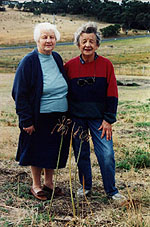The following was compiled by Marjorie Fox in 1986 from documents, and as told by G. Fox born Newington 1864-1937, R. Fox 1892-1966, W. Fox 1898-1965, H. Fox 1884-1919, and E. Fox 1913-.
|
"E. Fox began work in 1919 with his widowed mother and sisters on the 54 acre bush block, and still works and owns the property.
Among other documents we have one from 1861 - W. Fox bought of Lascelles and Tozer, cow and calf for £6/5/-.
A colony of early settlers bought holdings of 10-20 acres of Fenwick station on the brow of the hill, cut by the Barwon River, around to the southern boundary at Ocean Grove (Guthridge Street, Field Street, east along Thacker Street). From cottages the fishermen, Stephens, Blackwell, Bounds, Plummeridge, left the jetty (Guthridge Street) to fish the ocean.
A big flood cut the present course of the Barwon River, leaving the old course as a gutter (Ned's Gut), along which two fishermen, Luckow and Edmond Ferris brought their boats and catch to their homes on the south side of School Hill (Present owner, Pacey). The fish were transported in baskets (similar to a clothes basket with lid) by 2 wheeled spring cart, the three miles to meet the fish cart at the Queenscliff Road, coming from Queenscliff to Geelong Railway Station.
A sailing dinghy was moored at Pacey's Bridge, a 8' - 9' deep pool in the gutter. This was a popular swimming place Sunday mornings for 13-15 young men from the families of Anderson, Bail, Harding, Ling, Fox; in the afternoon they attended church.
Interned in the cemetery on the Ferris property were a child Jennie Ferris 1850, four adults and five infants to 1894.
Over the brow of the hill were the farmers. Early settlers names included Martin, Williams, James, Gibb, Butler, Chambers, Fox, Gibson, Riley, Thomas, Matcham, Sutherland, Barber, Hill, Ling, Harding, Pacey.
One such gardener was William Fox, an immigrant in 1856 from Somerset, England, who brought roots and cuttings of fruit trees, walnut, almond, mulberry. From the 120 trees that grew on each side of the gully, he was a pioneer selling apples commercially to H. F. Richardson, Geelong, when their premises was a tin shed.
In 1863 a church was built on land given by William Fox; he also gave land to the shire to make a road, known as Hardings Road. Gravel was purchased from land owners to maintain roads. For a fee cows were registered to graze on council roads. Children of the family, coming home from school were given the chore, first to find the cows in the "long paddock" then bring them home for milking. The original 10 acres of William Fox has been handed down to the fifth generation and children from each generation have and are attending the local Wallington School.
Special gatherings were held in the school to raise money for a hall which was built 1933. Members of the first committee were Ted Baglin, President; Frank Mullins, Secretary; Fred Jury, Treasurer; Oliver Harding, Bert Mattock, Archie Smith, Ted Fox.
The bullock wagon track from Queenscliff Road to Ocean Grove was clearly visible around 1915, the way of least resistance cut through the bush of Wallington and Fenwick, holdings of Mullins, Fox, Harding, G. Chambers. The remains of the holding yard for the bullocks were standing 1975. Signs are to be seen where aborigines removed bark from trees to make canoes.
During the 1900's the coach of Cobb and Co. carried the mail bags from the Wallington Hotel; for a time delivered a bag to the Wallington School, the children in turn delivered on their way home. A bag was left at the Fenwick Post Office. This office served its purpose only a short time, rainfall was recorded. Miss Charlotte Fox being Post Mistress.
The delivery stable for change of horses in Ocean Grove was at 55 The Parade. The timber structure, loft, stable, harness room and coach house was pulled down for Burns the wrecker, about 1940 by E. Fox and "an old chap who did some work for Pacey and drove an old Overland car."
Taking produce to the weekly markets in Geelong progressed from the horse drawn vehicle to the motor. An early truck about 1914, was owned by Ling, a chain driven Willeys-Knight, "could hear it miles away".
Market days were a pleasant change from manual labour on the farms. The horse fed and watered, the produce on the cart, an early start. So unhurried was the trip that you knew everyone between here and there; a friendly greeting to all. To the growers from around Geelong, many of them Chinamen. A chance to chat in street and shops while getting provisions and the horse resting and feeding.
The road dividing the holding owned by Fenwick was named Bush Road to the east and Back Road running off Martyn Road. The area was attractive with virgin bush, birds, wild flowers and native animals. A gravel road lined with gum trees, orchards, and families each with the same purpose, to build a home and make a living from the land.
The road was sealed part way in 1946, electricity connected in 1951 and water laid from State Rivers a year or two later. Subdivision to five acre blocks in 1965 from road frontage of Pacey, Fenwick.
Livelihood in the early days was from cutting firewood and stripping wattle-bark while clearing ground; with pick, axe, shovel, mattock and trawaler jack, for grazing, orchards, market gardens; early potatoes grow well in the area, and poultry farming.
Much of the Wallington-Fenwick area has been subdivided. Acres of potatoes for market are being grown. Of the 26 or more orchards, the remaining four are operating from roadside stalls, along with strawberries and produce. Selling on the roadside was inevitable since auctions ceased in Geelong about 1956."
[Marjorie Fox, Ocean Grove.]








